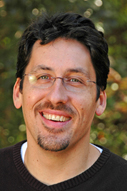 As part of the Digital Curation Institute’s Lecture Series 2014, on January 20 guest speaker Christopher (Cal) Lee gave the first DCI lecture 2014 and held a hands-on workshop.
As part of the Digital Curation Institute’s Lecture Series 2014, on January 20 guest speaker Christopher (Cal) Lee gave the first DCI lecture 2014 and held a hands-on workshop.
Materials with cultural, administrative, scholarly and personal value are increasingly “born digital.” Collecting institutions —libraries, archives and museums (LAMs)—have unprecedented opportunities to acquire and preserve traces of human and associated machine activity through access to both consciously created electronic records (e.g. word processing files, databases, spreadsheets, email, multimedia productions, social media) and various other inscriptions that are the result of interactions with a computer (e.g. system logs, configuration files, filesystem metadata). Likewise, researchers have unprecedented opportunities to discover and learn from those traces. In order to fully realize these opportunities, LAMs must be able to extract digital materials from their storage or transfer media in ways that reflect the metadata and ensure the integrity of the materials. They must also support and mediate appropriate access: allowing users to make sense of materials and understand their context, while also preventing inadvertent disclosure of sensitive data.
Digital materials can be considered and encountered at multiple levels of representation, ranging from aggregations of records down to bits as physically inscribed on a storage medium; each level of representation can provide distinct contributions to the informational and evidential value of the materials. There is a substantial body of information within the underlying data structures of computer systems that can often be discovered or recovered, revealing new types of records or essential metadata associated with existing record types. Many digital forensics applications and strategies can aid LAMs in their work, particularly by advancing three fundamental archival principles: provenance, original order and chain of custody.
Christopher (Cal) Lee is Associate Professor at the School of Information and Library Science at the University of North Carolina, Chapel Hill. He teaches courses on archival administration; records management; digital curation; understanding information technology for managing digital collections; and acquiring information from digital storage media. He is a lead organizer and instructor for the DigCCurr Professional Institute, and he teaches professional workshops on the application of digital forensics methods and principles to digital acquisitions.
Cal’s primary area of research is the curation of digital collections. He is particularly interested in the professionalization of this work and the diffusion of existing tools and methods into professional practice. Cal developed “A Framework for Contextual Information in Digital Collections,” and edited and provided several chapters to I, Digital: Personal Collections in the Digital Era published by the Society of American Archivists. Cal is Principal Investigator of BitCurator, which is developing and disseminating open-source digital forensics tools for use by archivists and librarians. He was also Principal Investigator of the Digital Acquisition Learning Laboratory (DALL) project, which incorporated digital forensics tools and methods into digital curation education. Cal has served as Co-PI on several projects focused on preparing professionals for digital curation: Preserving Access to Our DigitalFuture: Building an International Digital Curation Curriculum (DigCCurr), DigCCurr II: Extending an International Digital Curation Curriculum to Doctoral Students and Practitioners; Educating Stewards of Public Information for the 21st Century (ESOPI-21), Educating Stewards of the Public Information Infrastructure (ESOPI2), and Closing the Digital Curation Gap (CDCG).

